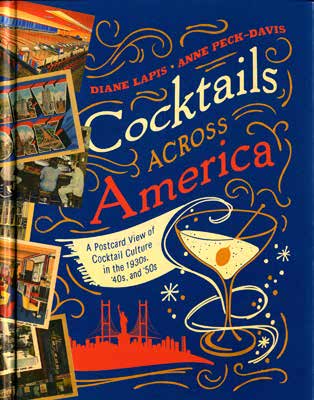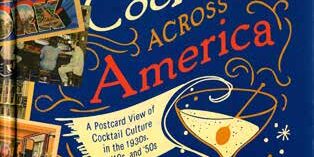Cocktails Across America: A Postcard View of Cocktail Culture in the 1930s, ’40s, and ’50s
By Diane Lapis and Anne-Peck Davis
New York: The Countryman Press, 2018
223 pages, $24.95 hardcover
Reviewed by Harold Aurand Jr.
 Diane Lapis and Anne Peck-Davis probably had no plans for contributing anything to the field of commercial archeology when they were writing Cocktails Across America. Avid collectors of old linen postcards, they noticed that a big part of their collection was focused on restaurants, supper clubs, and other establishments from the 1930s through the ’50s, where drinking, especially cocktails was the order of the day.
Diane Lapis and Anne Peck-Davis probably had no plans for contributing anything to the field of commercial archeology when they were writing Cocktails Across America. Avid collectors of old linen postcards, they noticed that a big part of their collection was focused on restaurants, supper clubs, and other establishments from the 1930s through the ’50s, where drinking, especially cocktails was the order of the day.
These were the decades after Prohibition when Americans could legally imbibe again. Entrepreneurs tried to attract customers by offering new and unique tastes, with décor that let them know they were in a special place. The authors wanted to link up their old postcards with a history of the tasty concoctions mixologists were creating. Accidents do happen, though, and I think this book appeals even more to people who are interested in the buildings where drinking was done, than those who are interested in the drinks.
Lapis and Peck-Davis arrange their book around the cocktails, grouping them in chapters according to the region where they were developed, or a unique theme. They describe the business where each drink originated, including a brief history, and, in many places, information on the building’s architect, and the reasons behind his choice of décor. Then we learn the exact circumstances leading to the creation of the cocktail, its recipe, and, of course, the postcards.
The postcards can be divided into three groups: some show an exterior view of the building, others interior shots of the lounge or dining areas when they were empty, and last are action shots showing people using the space, drinking, dancing, or otherwise enjoying a night out.
The linen postcards are the highlight as the colors just jump off the page. Many of the buildings still exist, but changes in taste and customer demand have dramatically changed the interiors. Seeing pictures of people using these spaces, dressed for an elegant night out, is a good reminder of how much social life has changed. Once, Mr. and Mrs. Average from a small town could dress up and go to a supper club where the big band music and surroundings were designed to remind them of a set in a Fred Astaire-Ginger Rogers movie. Today most communities lack an upscale-looking nightspot for people of moderate means.
Lapis and Peck-Davis also did an excellent job of shining a spotlight on several less well-known cultural themes. Everybody probably knows and has seen pictures of tiki bars and how they tried to create a South Seas atmosphere for drinkers. Today there is a small cottage industry recreating and furnishing such places. I had never before heard of establishments with small ice rinks where skaters would perform during dinner, then afterward, the rinks would retract under the orchestra platform to provide room for dancing. Apparently, these were common. The book also looks in some detail at bowling alleys as sites for cocktail lounges.
Overall, this is a well-researched and particularly well-illustrated book. The authors have done outstanding work in bringing all of these pictures and descriptions of drinking establishments together in one place. Anyone doing research on their own local lounge, supper club, or nightspot will find something to compare them with. At the end of the book are four, full-sized copies of vintage postcards you can punch out and mail to your friends. Oh, and if you decide to try any of the recipes watch out—some of them pack a punch!
Harold Aurand Jr. has been a Professor of History and American Studies at Penn State-Schuylkill Campus since 1992. Unfortunately, he doesn’t get to teach nearly as much about the roadside environment as he would like.
This book review originally appeared in the SCA Journal, Spring 2019, Vol. 37, No. 1. The SCA Journal is a semi-annual publication and a member benefit of the Society for Commercial Archeology.
More Book Reviews


